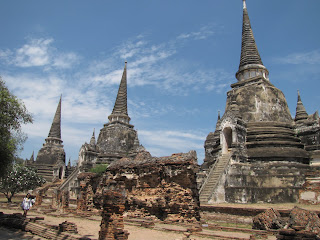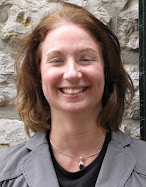



The day began with an unexpected, but delightful short visit to the home of the father of Rujapa Jiamtanopachai, a wonderfully charming young lady who is a member of the incoming GSE Team to our District. Rujapa has been accompanying us daily, helping us through the some of the language barriers that we have encountered and, in general, solving any small problems that inevitably occur in a trip such as ours. Those of you who will meet Rujapa while she is visiting Virginia are in for a real treat. Her father treated us to refreshments and presented us with small gifts which he had made.
Today was a potpourri, complete with activities that diverted from the itinerary and frequently tested the team’s flexibility and ability to adapt. Instead of going to the originally planned visit to a film studio, with a viewing of a famous Thai historical film and then a visit to a farm, we wound up taking a long drive through the countryside to a hot spring.
Had we known to bring swim suits we probably would have been better prepared for a pleasant dip. However, rising to the occasion, the team purchased some appropriate shorts at the spring and continued on as though this was what we planning to do all along. Unfortunately for me, Thai men are not built to my proportions (girth) and, try as I might, I was unable to find anything that came close to my size.
As my team relaxed in the hot spring, I was forced to submit to a one-hour Thai massage. (Why don’t I hear wails of pity?) For one hour I was kneaded, pummeled, twisted and probed by a slightly built lady with incredibly strong hands. I thought that I might never walk again but, surprising, after the ordeal, I felt great.
We next proceeded to the Hellfire Pass museum. Funded mainly by Australia, the museum was built as a memorial to those who had perished building this particularly mountainous stretch of the same railroad that we had visited the previous day, over the River Khwae. In sharp contrast to the museum in Kanchanaburi, which had left me disappointed, this museum was well-organized and informative, with a marvelous view of the steep terrain through which this section of the railway had been built, adding to our appreciation of the achievement.
Whisking us back to Kanchanaburi, our hosts prepared the team to attend a wedding celebration for the daughter of one of the Rotary club presidents. Whereas my host had told me to dress in a white shirt and tie (no jacket) which was perfectly appropriate, the rest of the team’s hosts had conspired to outfit them in formal Thai clothing and, for Brooke, Amanda and Jennifer, new coiffures. When they arrived at the banquet hall (an intimate gathering for about 500 of the family’s closest friends and relatives) I was hard-pressed to recognize my own team.
I was treated royally and was included in a family photo taken with the bride and groom, the bride’s parents and the District Governor Nominee, with whom I sat at dinner. DGN Somphop is a delightful man with a marvelous sense of humor, who made me feel quite at home, translating the goings-on into English for my benefit.
For the entire team, the evening was a rare opportunity to be immersed into an aspect of the Thai culture that we might not ordinarily see. It certainly reinforced the universality of love.

































